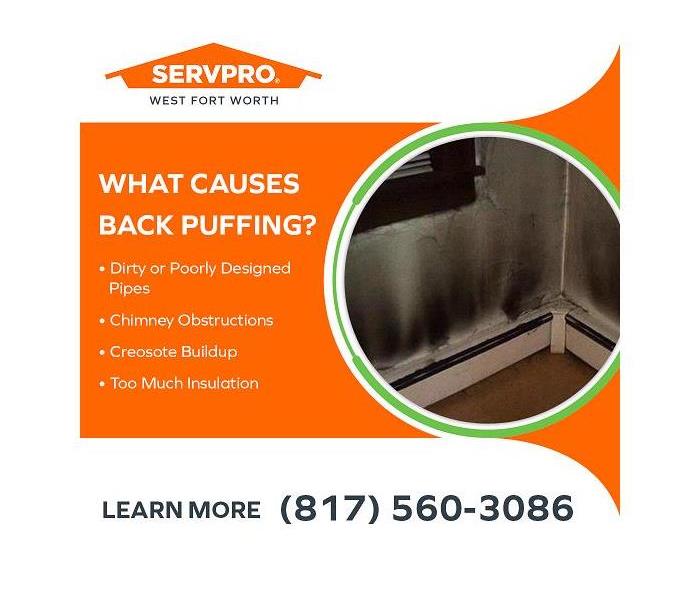What is Back Puffing: Origin and Tips to Avoid Potential Risks
9/14/2022 (Permalink)
Blog Summary: SERVPRO of West Fort Worth's expert team explores the common issues that cause back puffing in homes and what homeowners should do when faced with this problem.
During frigid winters, furnaces keep millions of homes toasty warm across the United States. But furnaces come with a little-known risk: back puffing.
Essentially, a puff back is a sudden explosion in a furnace due to vapor buildup. This process forces smoke, soot, and fire to spew out of the furnace and through the home's ducts.
Fire damage from back puffs causes severe damage and requires assistance from a fire damage restoration company like SERVPRO of West Fort Worth.
What causes back puffing?
Many factors can trigger a furnace, fireplace, or stove to start back puffing. Back puffs happen most frequently in oil furnaces but can occur in forced-air or gas furnaces.
Some of the most common reasons include:
Dirty or poorly designed pipes
Furnaces require maintenance to function safely. Homeowners should schedule routine maintenance at least once a year and have the furnace professionally cleaned twice a year to remove soot buildup that causes back puffing.
Smoke does best when flowing out of a vertical pipe system. Any turns inside a piping system make it harder for smoke to escape and lead to the vapor buildup that causes back puffing.
Chimney obstructions
An obstructed chimney results in restricted airflow, causing smoke to build up in a homeowner's piping system. This escalating pressure eventually becomes a back puff, putting the building at risk of fire damage. Chimney obstructions are usually bird nests, branches and twigs, and the occasional wasp nest.
Creosote buildup
When using a fireplace, smoke coats a flue's interior and leaves behind a substance called creosote. Smoke produces more creosote the more a homeowner uses their fireplace. This substance is extremely flammable and reduces a chimney's ability to function correctly.
Homeowners should regularly have a team sweep their chimneys to prevent obstructions, creosote buildups, and future fire damage.
Too much insulation
Many homeowners believe that the more insulation, the better. However, a building with too much insulation may lead to a back-puffing furnace. Fire needs oxygen, and too much insulation restricts the airflow necessary to keep the fire going, which creates ideal conditions for a back puff.
Homeowners can open up a window next to the fire source to see if this takes care of the problem.
What homeowners shouldn't do after a back puff
If a homeowner's furnace has back puffed, there are some things not to do to minimize the fire damage:
- Don't use items exposed to back-puffing: Homeowners shouldn't use items like furniture or carpeting if excess soot or smoke gets on them.
- Don't turn on electronics before checking them: Homeowners should always have a professional fire damage restoration company inspect electronics like TVs, computers, and stereos to ensure safety.
- Don't attempt DIY soot cleanup: Cleaning smoke and heat often requires expert services. In particular, soot leaves long-lasting stains when homeowners use the wrong cleaning method.
Fire Damage Preventative Measures from SERVPRO
Back puffing can cause fire damage to a residential or commercial property. Preventative measures are the best way to avoid back puffing and its associated risks.
For over 50 years, SERVPRO of West Fort Worth has provided expert fire damage restoration and prevention services in Benbrook, TX. Contact Team Shaw of SERVPRO of West Fort Worth at (817) 560-3086 to learn more!






 24/7 Emergency Service
24/7 Emergency Service
